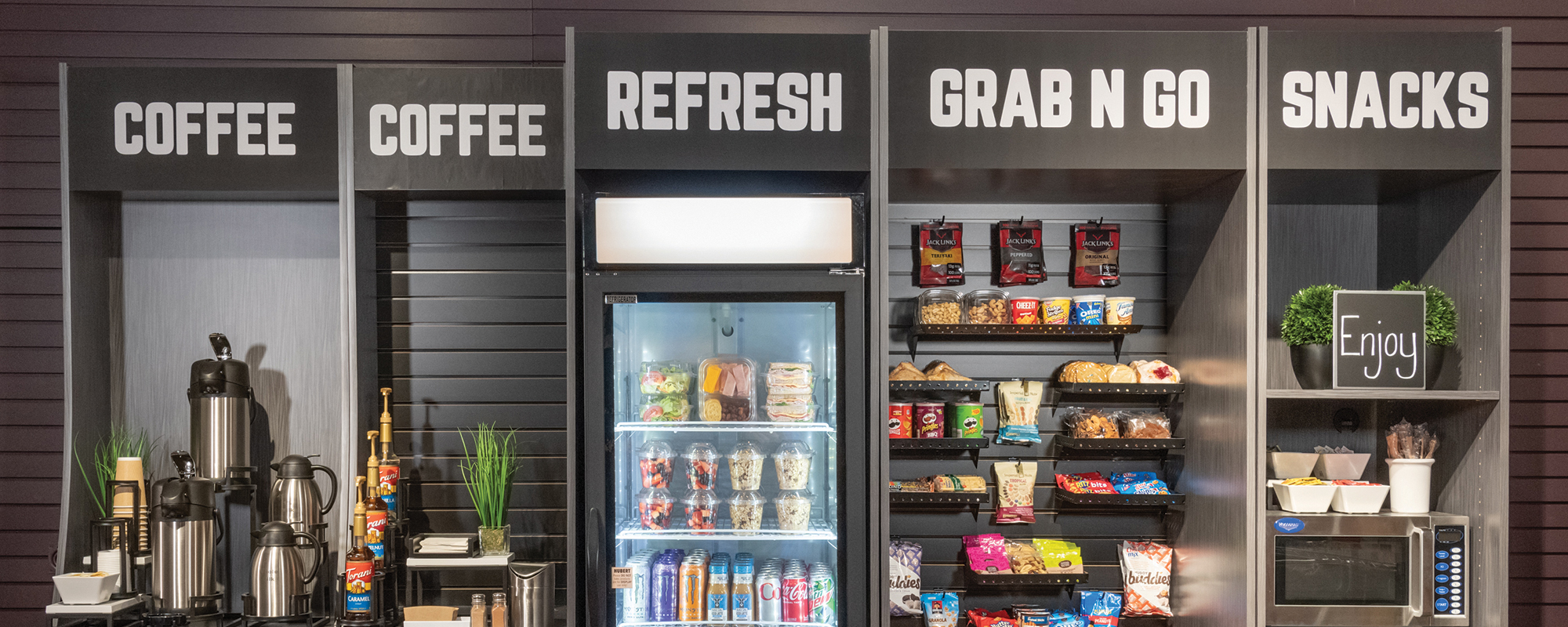
We care a lot about your experience on our website. Please tell us how we can improve.
If you want an immediate response, chat with us now
We've all been there. You rushed out the door to get to the office on time and forgot to pack a lunch. You historically have only two options: join the rush of other office workers ordering fast food and trying to return to work in under an hour or to try your luck with the vending machines. The options for office workers have been limited for decades but with the increasing popularity of micro market, you may be asking if it is something you should consider investing in at your office.

A micro market is a self-service, mini market that has a greater offering than a vending machine. Micro markets can feature healthier food options, snacks, and even common medicines. The options provided at micro markets are fresh and healthier than just the snack options at a vending machine. Your employees and even your customers can purchase products from the open shelves, coolers, or freezers for an on-site lunch, business meeting, or the mid-afternoon snack. To create an accurate micro market vending definition, we need to also understand what makes them so popular and the benefits they bring.
Not everyone in the office is a planner, or for that matter, even a cook where they can pack their lunch every day. A recent survey revealed that 90% buy at least one meal per week. So, when 12:00 P.M. rolls around, many of your workers will start to consider where they will go to get their lunch that day. According to the same survey, 63% got their lunches from nearby restaurants while 18% used the workplace cafeteria and 16% get their lunch from a grocery store.
Not only do micro markets give you a chance to provide lunches and snacks that your employees are craving for purchase, but it also provides them with convenient options for less hassle than other options near the workplace. This gives workers extra time in their day to do what they want on their lunch break such as run errands, take a nap, or exercise.
As an employer you want to offer perks to your employees, but it can be hard to justify if that perk costs you money in the long run. Micro markets can be highly successful and a refreshing option that promotes your employees' overall health and wellbeing. But if you don't do the research and collect data on what types of foods your employees want then there is a potential for a micro market to fail.
The key feature of a micro market is in the types of foods and snacks you offer. A micro market kiosk will have more options than a vending machine, but it isn't a full grocery store. So how do you make sure you have items that your employees are craving? The answer is to collect data so your micro market is stocking items that people want. You should find out if you have any people in your office with special dietary restrictions or allergies.
The size of your office matters too! If you have a small office of 50 employees or less, micro marketing vending may not be the right option for you. With the main offering of micro market technology being fresh, healthy foods, you need to make sure you have enough people that would take advantage of the micro market to ensure you don't have food that spoils.

Several of the benefits of micro markets centered around their vast array of convenient products and how those products help consumers live a healthier lifestyle. Here is a closer look at some specific examples of items operators often put in their micro markets.
While vending machines are restricted to small snack items, micro markets have expanded to offer more oversized food items such as entire meals. Full meals are ideal for workers taking a quick lunch break or children in school who don't pack their meals. Some examples of typical meals include:
Since micro markets often replenish their stock daily, they can offer fresher options for customers. Here are a few snacks that are popular in micro markets.
Beverages keep consumers hydrated and give them an energy boost throughout the day. They are also the most popular products that consumers buy at micro markets. A few of the most popular beverages consumers often purchase from micro markets include:
Impulse buys are products that supermarkets will often keep next to the register. Consumers don't usually take a trip to the store for these items but will grab a few while checking out because of their convenient location. Here are some examples of impulse buys that micro markets can also keep in stock.
Consumers also appreciate micro markets for the non-food items it offers its customers. In addition, the large shelving areas are ideal for stocking everyday products consumers might need on the go because they forgot the item at home, lost the item during the day, or want to avoid a trip to a giant supermarket to buy a single product. Here are some ideas of non-perishables to stock in a micro market.
The average transaction at a fast-food chain per person is between $4.72 and $6.04 according to Business Insider. By comparison, the average vending machine transaction is $1.75 per person. While micro markets are still fairly new, the potential to capture some of the lunch break sales is far greater than what you can make on a vending machine alone. Research shows that His research shows that while there are 1.9 daily visits to a typical vending location there are 2.3 daily visits to a micro market.
A micro market kiosk has minimal costs as you do not have to hire additional employees to operate. Micro markets feature self-service and payment, so all that is required is to maintain the restocking of your offerings.
The benefits don't end with the profits you can earn. Your employees will benefit from the convenience of having additional food options on-site, healthier snack options can improve morale, and they will have better quality lunch breaks with all the time saved by not having to wade through the lunch rush.
In our latest guide—The Complete Guide to Micro Markets—we highlight everything you need to know. Including:
Download a copy of your free micro market guide today.
DOWNLOAD HERE
Only Hubert delivers the expertise and products to solve complex challenges like overcoming the labor shortage, driving more food sales, and creating a memorable experience for customers.
For 75 years we’ve helped many industries—including hospitality, education, food retail, healthcare, retail, and more—overcome these unique challenges with our expertise and line of products, including displayware, display fixtures, décor, signage, bar & beverage, food prep equipment, large commercial equipment, ice machines, merchandisers, and back of the house equipment.
Want to learn more?
Talk to an expert.